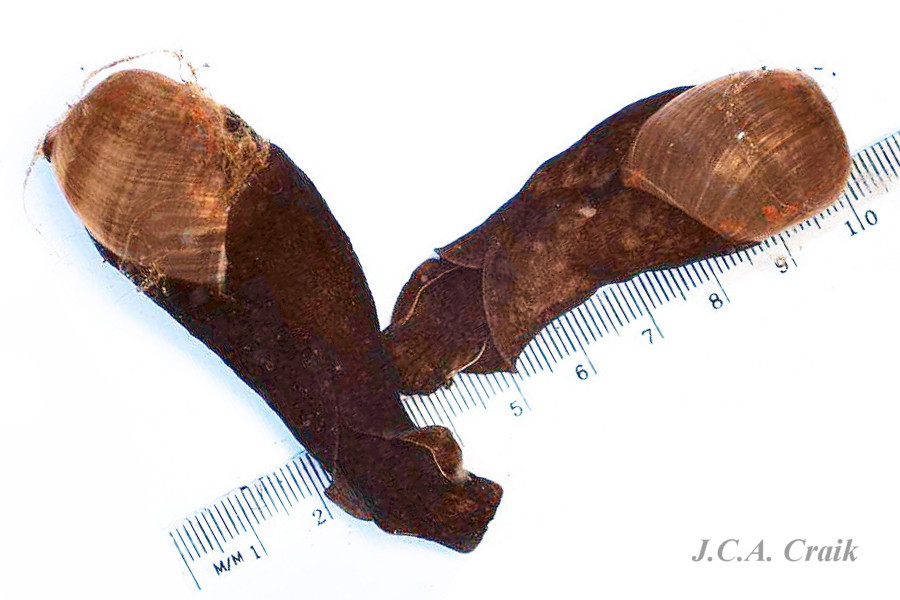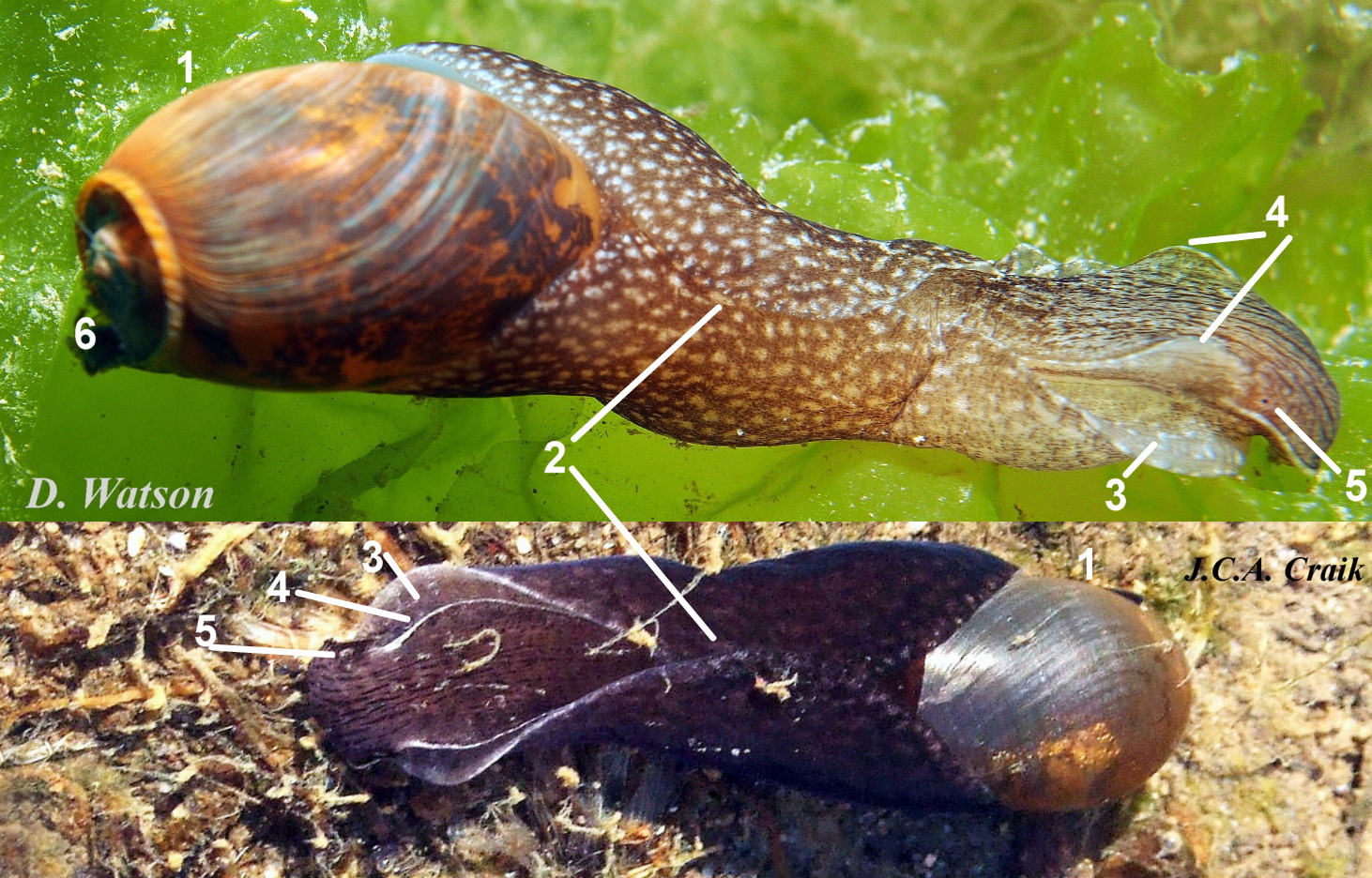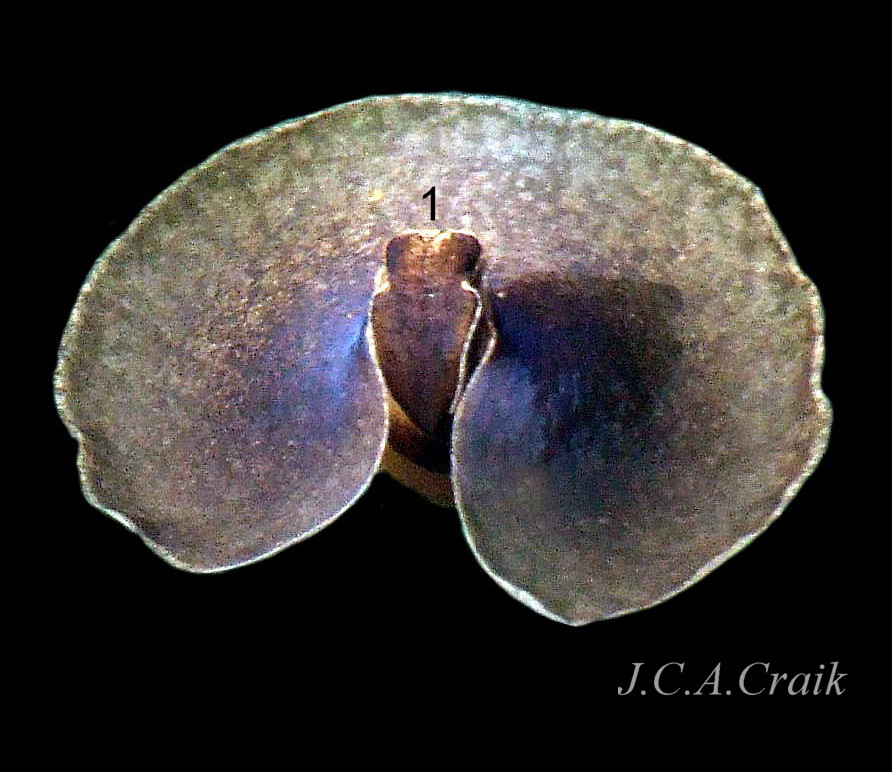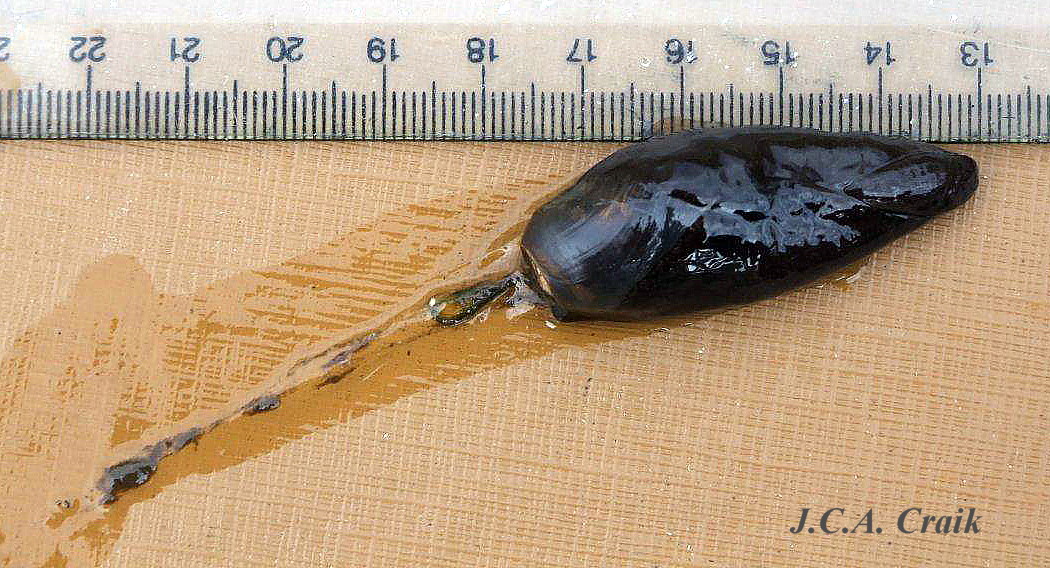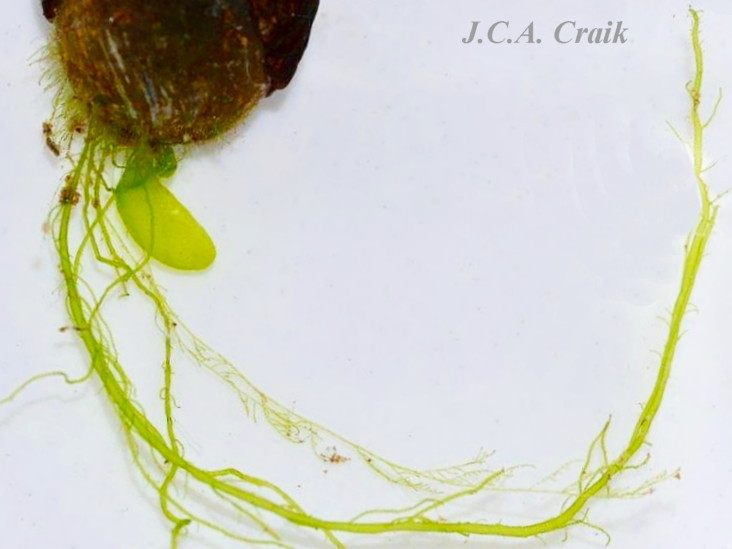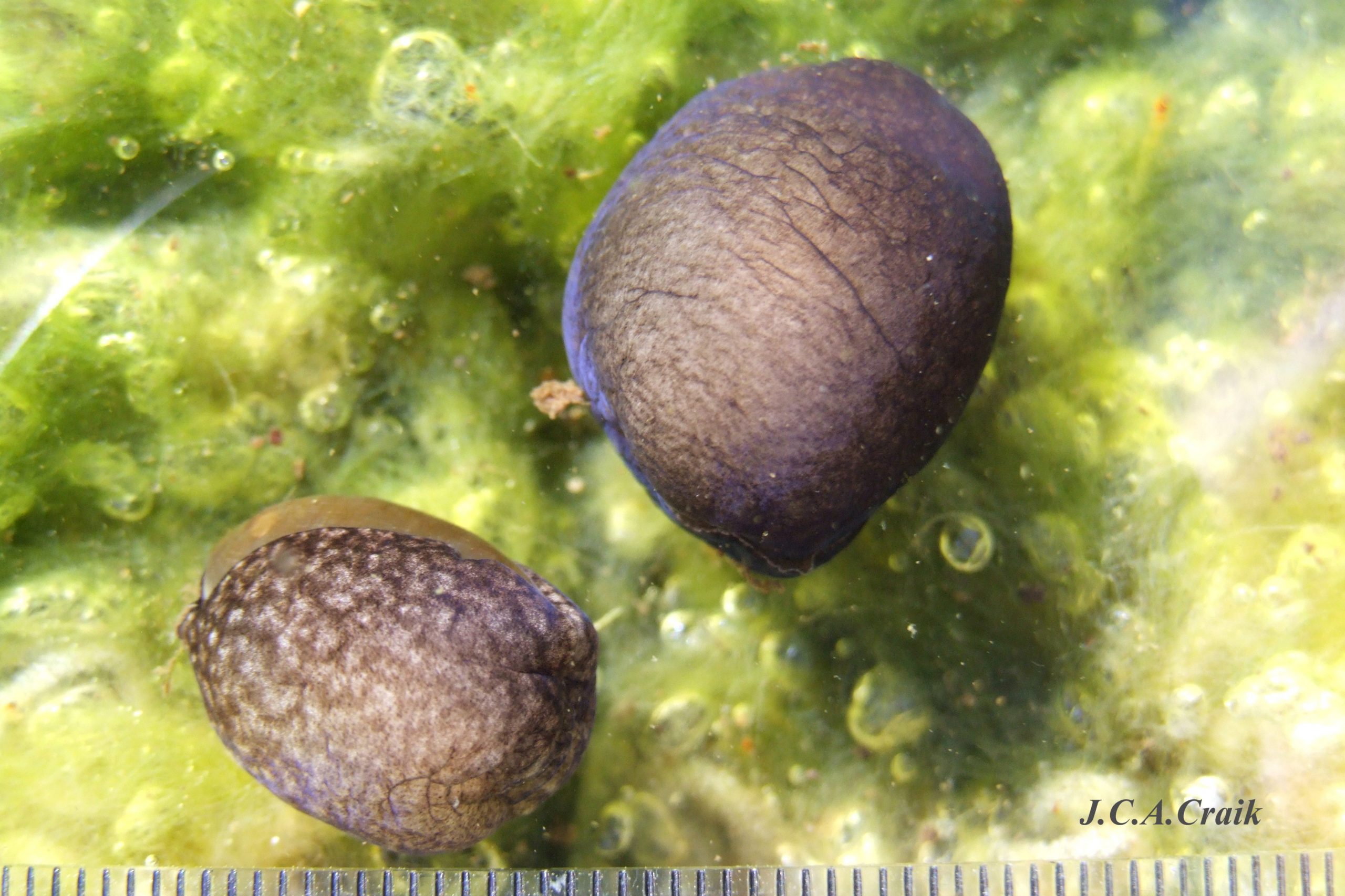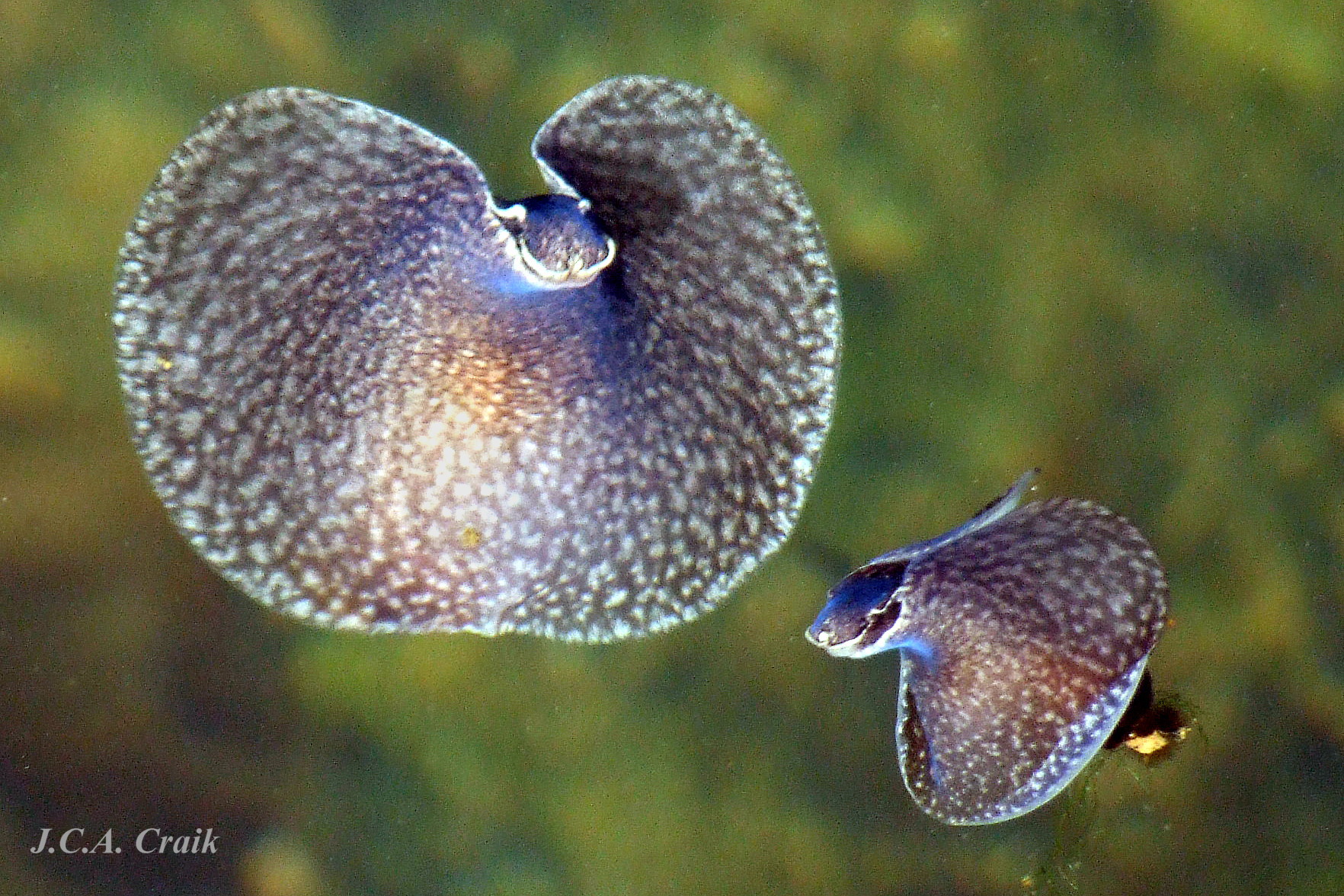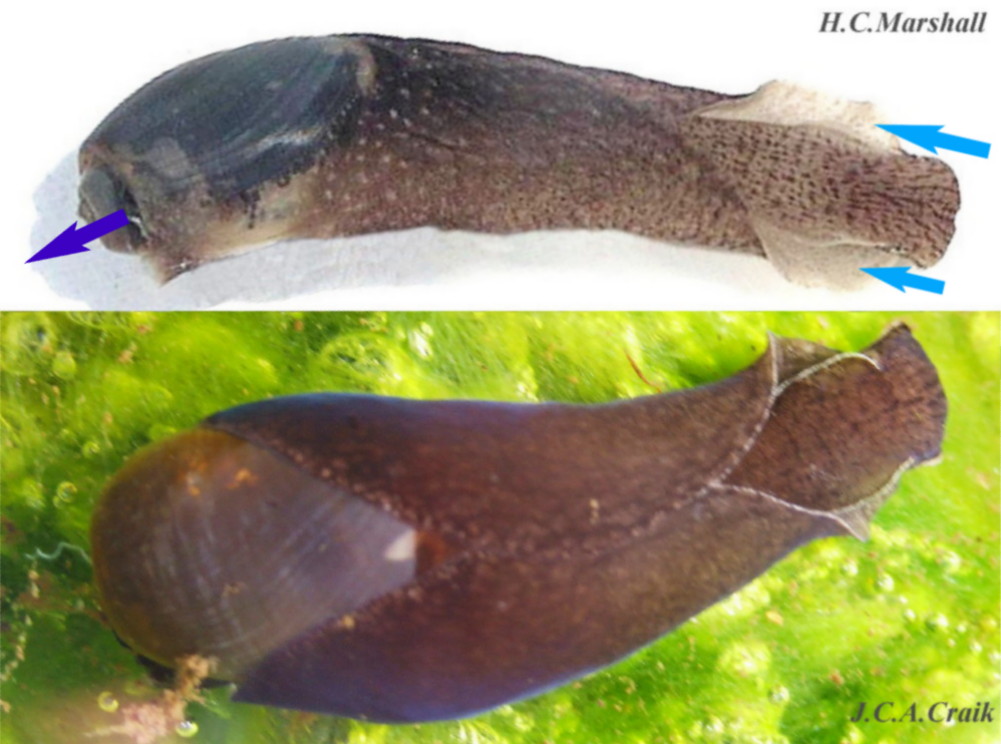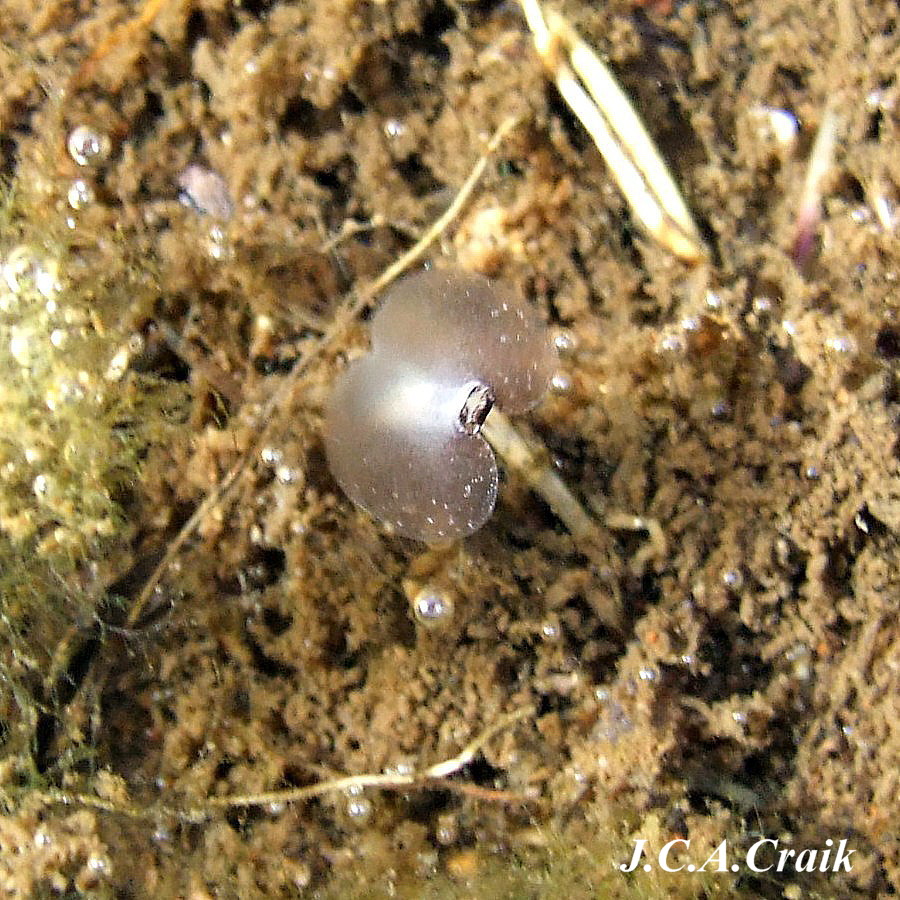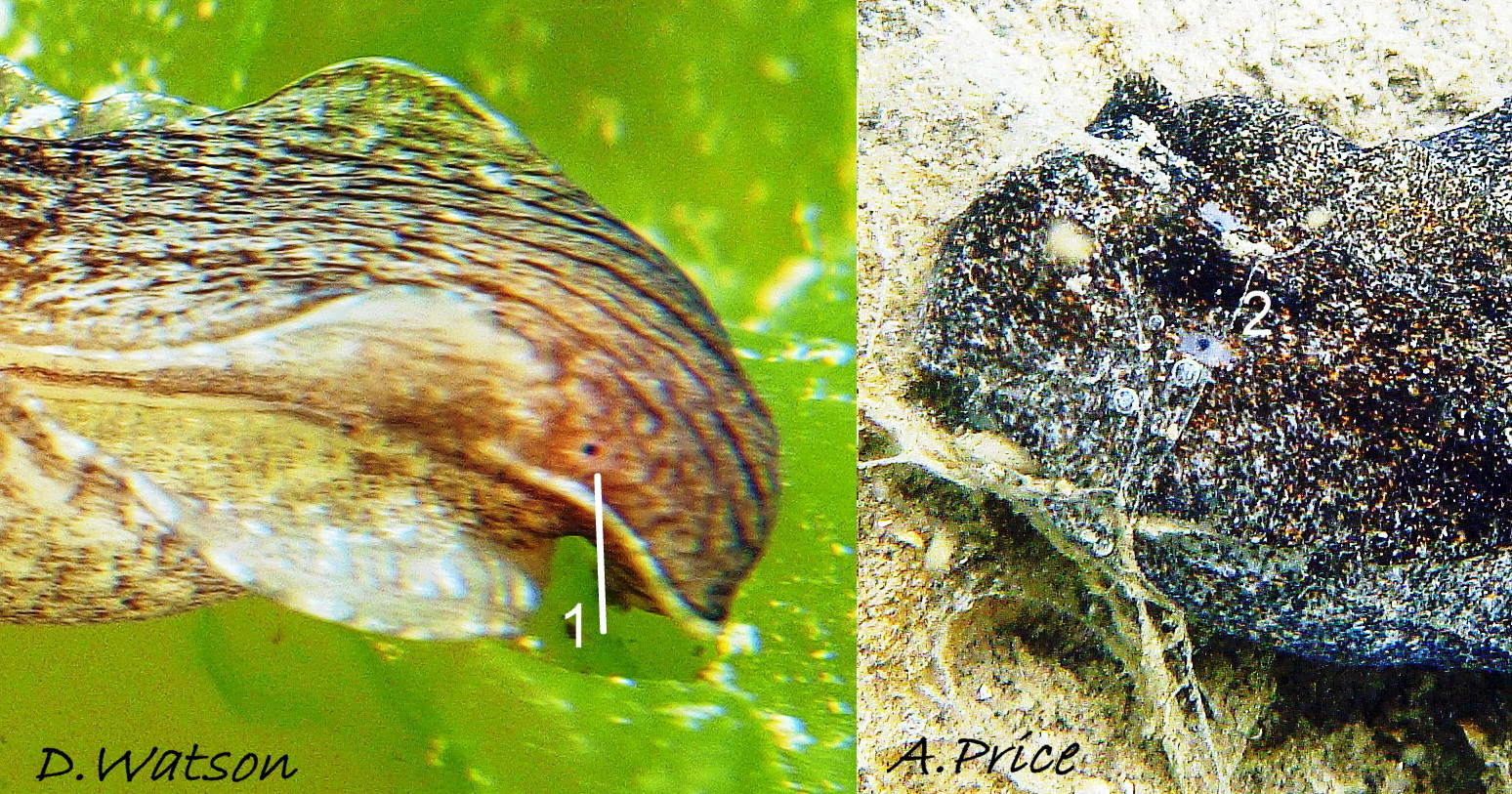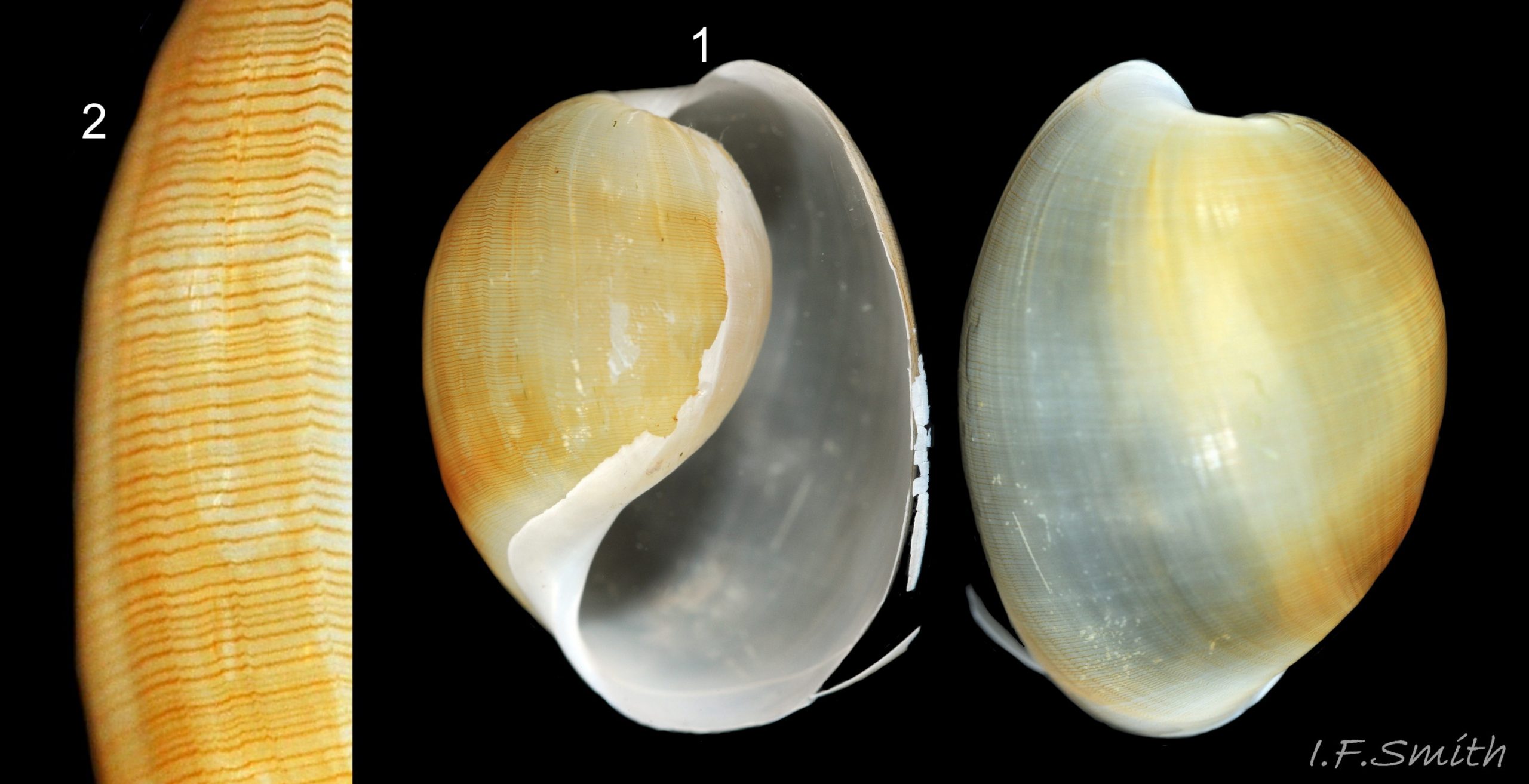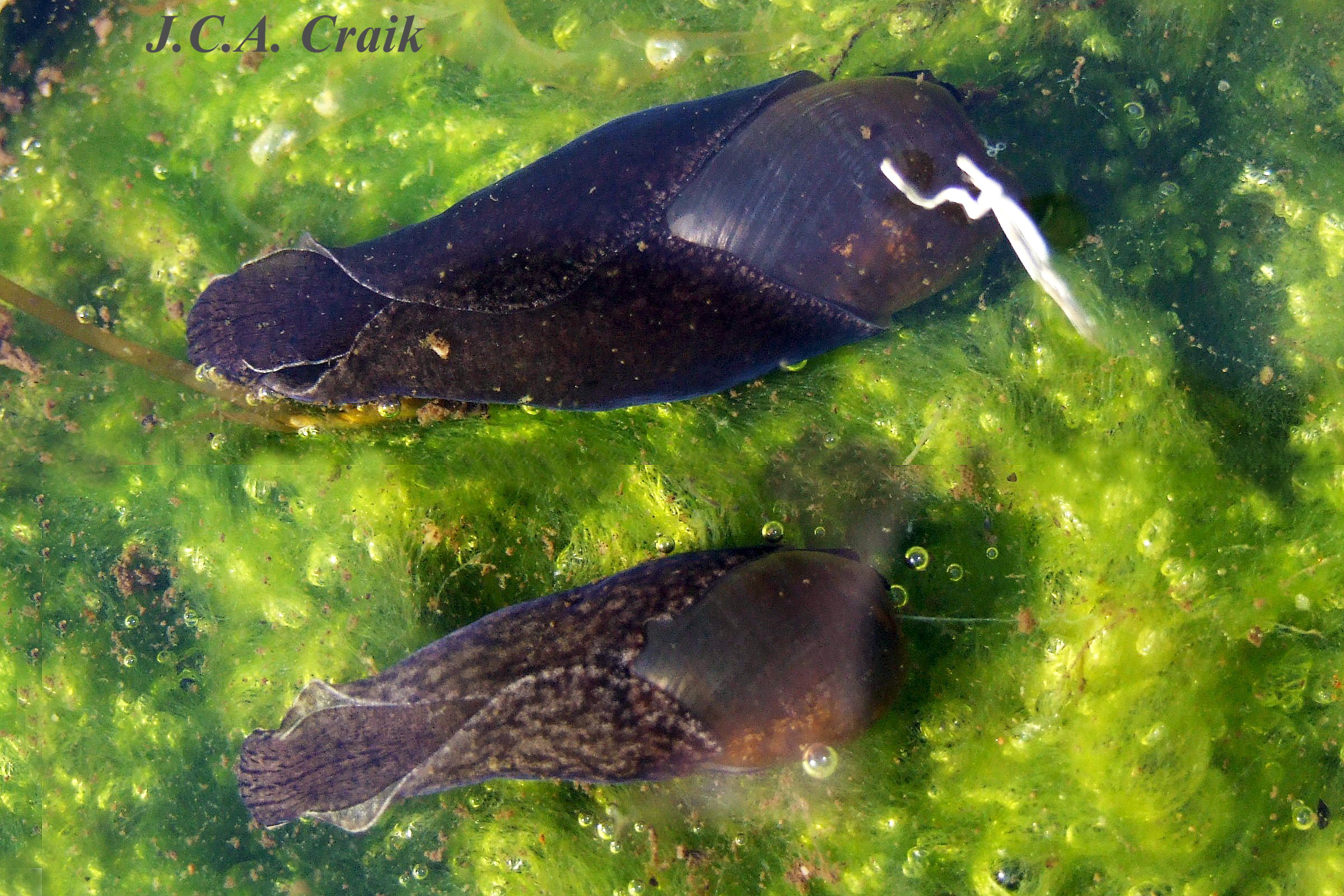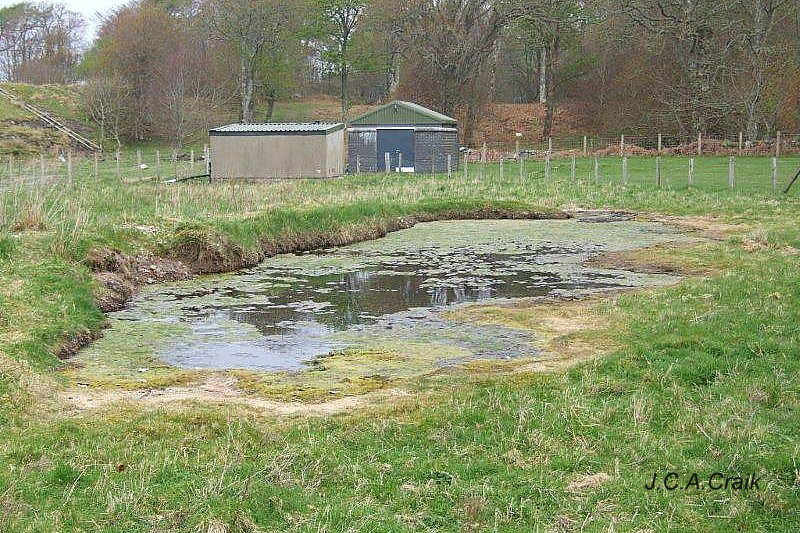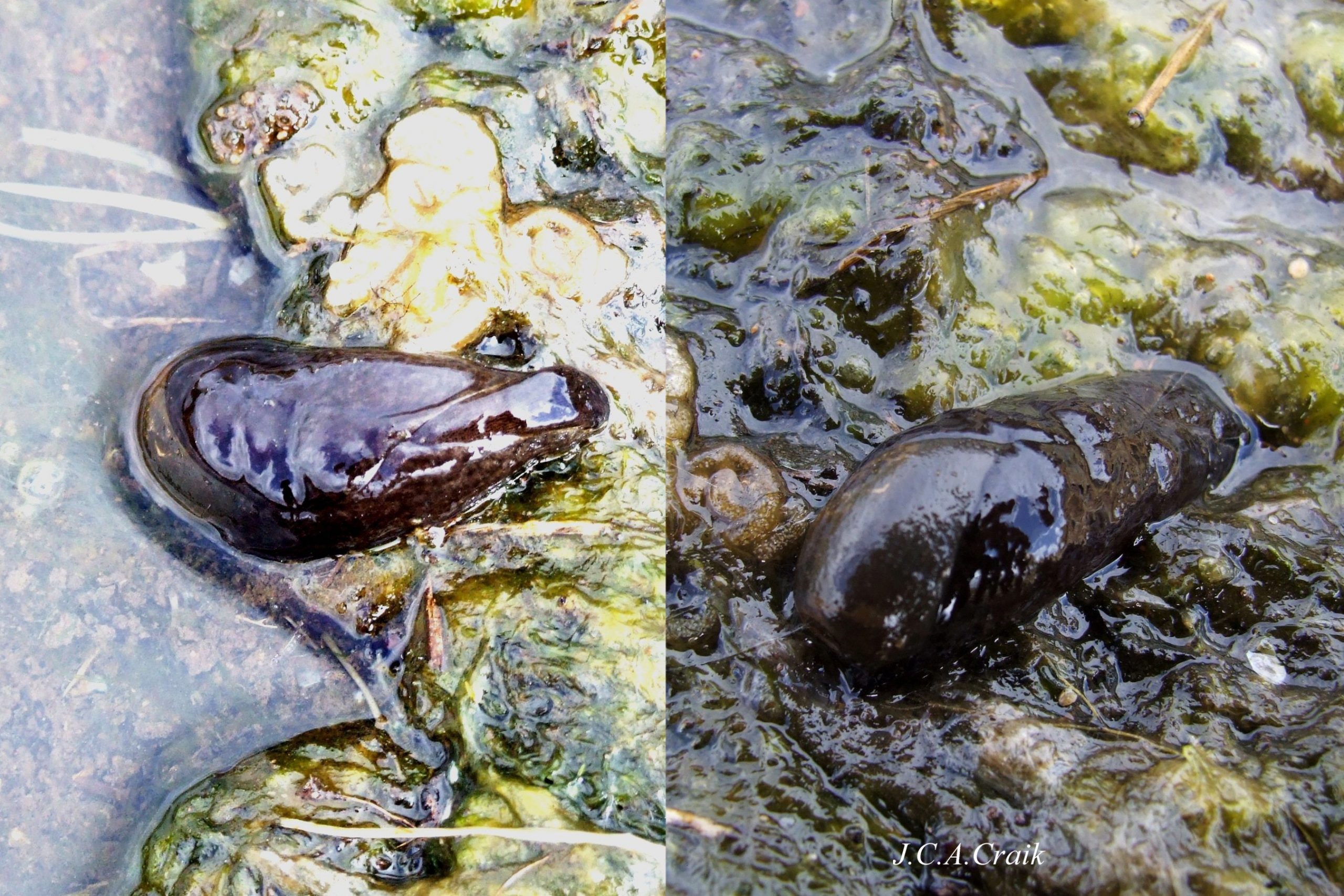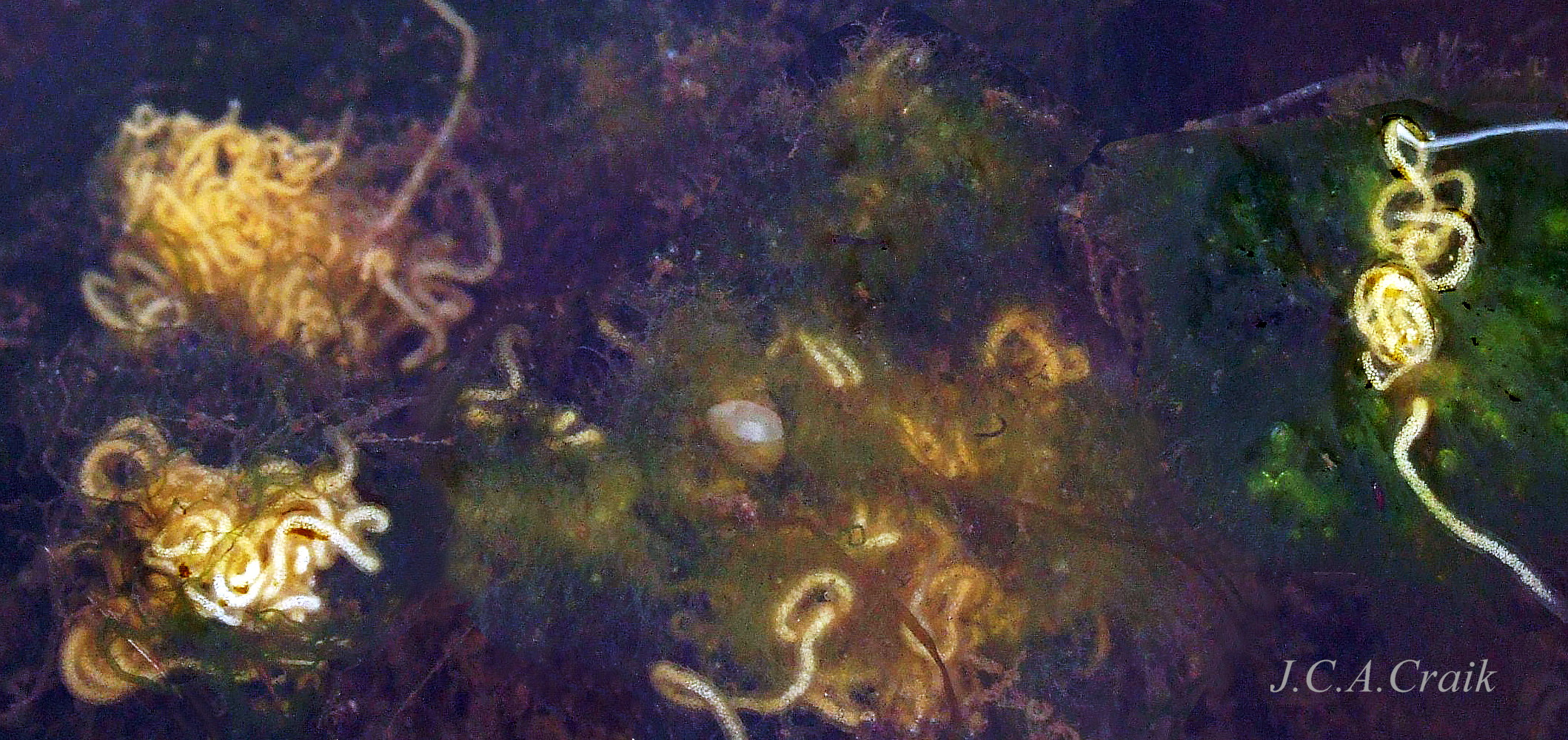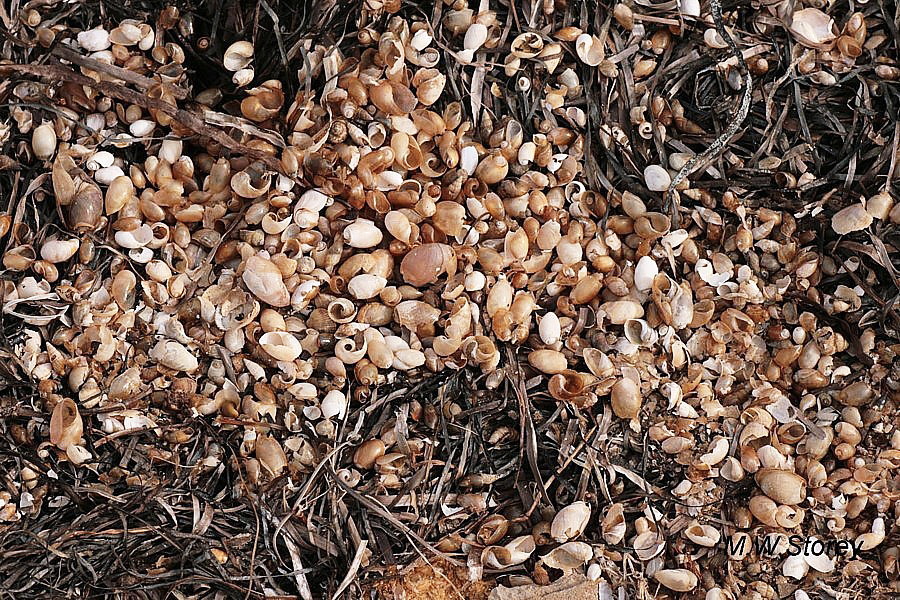Click image to enlarge with full caption. Main text below slider.
Akera bullata O F Müller, 1776
Authors: Ian F. Smith (text) and J. Clive A. Craik.
PDF available at www.researchgate.net/publication/353794397_Akera_bullata_…
Current taxonomy: World Register of Marine Species
www.marinespecies.org/aphia.php?p=taxdetails&id=138734
Synonyms: Aceras elegans Locard, 1886; Acera bullata [spelling variation];
Vernacular names: Bubble akera, Soft bubble-shell, Common bubble shell; Môrwlithen acera (Welsh); kuglesnegl (Danish); Kugelschnecke; Gemeine Kugelschnecke (German).
Body description
Akera bullata grows to a usual maximum length of 40 mm (Thompson, 1976) in the wild but, in the protection of captivity, it can reach 80 mm ( 01 Akera bullata. ) and a mass of 19g. The posterior of the body remains within the translucent shell which cannot accommodate the whole animal. The viscera colour, varying with diet, shows through the shell when living. The dorsal cephalic disc has curved antero-lateral expansions forming white rimmed ear-like lobes ( 02 Akera bullata. ) behind the inconspicuous lateral eyes (Forbes & Hanley, 1853, failed to find them). The radula has teeth adapted for grazing and raking. In addition, there are teeth in two gizzards for the attrition and filtering of ingested food (Morton & Holme, 1955). Its foot extends laterally into parapodia (wing-like lobes) which, when not swimming, meet and overlap over part of the body and shell. Even when tightly wrapped around the body, the anterior ends of the parapodia are held ajar for the admission of the respiratory water current (01 Akera bullata. and 08 Akera bullata). Their dorsal faces are concealed against the body until they are expanded for swimming, when the pale dorsal surface faces downwards and the ventral surfaces of the foot and parapodia face upwards. There is no visible demarcation between the identically coloured sole and ventral face of the expanded parapodia (07 Akera bullata. ). All body surfaces are smooth. There are no digitiform tentacles on the cephalic disc, but it is slightly bilobed ( 03 Akera bullata ) at the anterior.
Within the mantle cavity there is a gill of plicate, double folded, thin epithelium, lacking the filaments and current-driving cilia of the comb-like ctenidium of many other marine gastropod groups. Posterior to the gill there are a dorsal and a ventral raphe with dense cilia. A. bullata is a simultaneous hermaphrodite. The common genital opening, including the vaginal opening, is located dorsally well back on the body. An open external ciliated seminal groove runs forwards from it through the space between the body and right parapodium to the penis (retracted from sight when not in use) behind the right eye.
Many authors, such as Meyer & Möbius (1865 – 1872), described a pallial filament extending from the rear of the animal, but Müller (1776) made no mention of it. What they saw was probably a mucous filament ( 04 Akera bullata ) containing faeces or pseudofaeces extending from the posterior pallial cleft, or epizoic filamentous organisms (05 Akera bullata.) attached to the shell (Craik, 2013).
A. bullata contracts into a spheroid when alarmed (06 Akera bullata.) and moves its parapodia like a parasol when swimming (07 Akera bullata). Its epithelium is grey or brownish overlaid with light and dark blotches and, on the cephalic disc, dark streaks ( 08 Akera bullata ). Larger specimens are generally darker, approaching black ( 16 Akera bullata. ). The dorsal faces of the parapodia, which face downwards when swimming, are paler than the rest of the animal ( 09 Akera bullata. ). Very small, recently metamorphosed specimens (up to about 50 mg mass) are translucent and lack pigment (10 Akera bullata. ); dark pigment soon appears, and older individuals are usually darker than young ones (fig 16 16 Akera bullata. ).
Shell description
Maximum height (longest dimension) of the shell is usually 30 mm, occasionally 40 mm. It is a very thin, flexible, glossy, translucent, variably ovate ‘bubble’ with fine prosocline growth lines and close-set, wavy, microscopic, spiral striae ( 12 Akera bullata. ). Fresh shells have a filmy, but distinct, brownish-yellow periostracum (Jeffreys, 1867). When it is worn off dead specimens, the whitish to pale brown shell is less glossy (11 Akera bullata.). The mantle lining the interior of the shell is dark with light marks; it and the colour of the viscera often show through the translucent shell (Thompson & Seaward, 1986).
The truncated spire protrudes beyond the final whorl on some (11 Akera bullata.) or hardly at all on others ( 12 Akera bullata. ). Whorls are sharply angulated adapically. The suture is deep and accompanied closely around all whorls by a subsutural spiral slit (11 Akera bullata. & 12 Akera bullata. &) that is sealed by a membrane, apart from the body whorl which retains an open slit that allows the shell to flex. The membrane dries and cracks on dead shells, sometimes causing the slit to enlarge.
The aperture is shorter than the shell’s height (11 Akera bullata.), but sometimes almost equals it ( 12 Akera bullata. ). On unweathered shells, the columellar lip is whitish and slightly folded and protruded ( 12 Akera bullata. ). Internally, all whorls open to, and spiral round, the wide central cavity instead of a solid columella (11 Akera bullata.).
The several named shell varieties are probably growth forms of little taxonomic significance.
Key identification features
Akera bullata
1) Parapodia meet over the body and overlap ( 02 Akera bullata. ).
2) Ear-like lobes behind inconspicuous, lateral eyes (02 Akera bullata. & 14 Akera bullata).
3) Aperture long but does not extend beyond spire of shell (11 Akera bullata. & 12 Akera bullata. ).
4) Spiral subsutural slit in whorls, sealed by membrane on early whorls ( 12 Akera bullata. ).
5) No large lobe extends from the posterior.
Similar species
Haminoea navicula (da Costa, 1778)
1) Parapodia do not meet and overlap over body ( 13 Akera bullata COMPARISON Haminoea navicula. ).
2) Dorsal eyes lack ear-like lobes behind them ( 14 Akera bullata COMPARISON A. bullata & Haminoea navicula. ).
3) Aperture extends beyond spire of shell ( 15 Akera bullata COMPARISON Haminoea navicula ).
4) No spiral subsutural slit.
5) Wide, flat, pallial lobe extends from posterior ( 13 Akera bullata COMPARISON Haminoea navicula. ).
Habits and ecology
A. bullata lives near low water mark and sublittorally to 370 m (Thompson & Seaward, 1986) on mud and muddy sand, especially on Zostera and filamentous green algae, in sheltered bays, lagoons, tideless man-made ponds ( 17 Akera bullata ) and tanks containing seawater. Escapees from leaking tanks in the aquarium of the Scottish Association for Marine Science at Oban grew to great size ( 01 Akera bullata. ) in algae growing on the wet concrete floor (JCAC pers. obs.). It prospers best and grows largest where there are few predators or competitors for food (Morton & Holme, 1955, and JCAC pers. obs.). It feeds on green algae and, when adult, also on decaying organic matter. Their faeces and pseudofaeces consist of sand, silt and part-digested green algae. Large, irregular, uncompressed coils of fine, well-comminuted faeces bound by mucus break away from the anus at the edge of the posterior mantle cleft (Morton & Holme, 1955), and sometimes adhere to and trail behind the spire of the shell (04 Akera bullata , 16 Akera bullata. & 22 Akera bullata. ). Large concentrations of larger A. bullata gather on decomposing organic matter, such as rotting Zostera ( 21 Akera bullata. ), but do not eat living Zostera. The young are almost always found on filamentous green algae and seem to require it as they fail if it is not present, sometimes because all the algae are consumed by competing isopods (JCAC pers. obs.). It is eaten by flat fish, ducks and, when swimming, Aurelia aurita jellyfish catch it (IFS per.obs.). When threatened, some can discharge defensive ink. Those in the Fleet lagoon feed on Zostera and cannot discharge ink, unless fed on red algae in the laboratory (pers. comm. H.C. Marshall).
Respiration: (Morton, 1972). The plicate, folded gill within the mantle cavity relies on the respiratory water current created by the cilia on the adjacent dorsal and ventral raphe. The pallial opening is a long narrow slit running the length of the shell aperture and is sealed by the meeting of the suprapallial lobe, which is reflected over the outer lip of the aperture, with the infrapallial lobe, which spreads over the body whorl below. Only the anterior and posterior ends are left open for the passage of the inhalent and exhalent currents. The inhalent current enters via the gaps between the head and parapodia ( 08 Akera bullata ), passing over the chemoreceptive Hancock’s organ which tests the water quality. The exhalent current exits through a narrow rectangular cleft, the so called exhalent siphon, situated at the subsutural split in the shell at the posterior of the animal. The infrapallial lobe is drawn into a backward facing gutter and the suprapallial lobe has cilia which assist the exhalent current.
Reproduction. Because the positions of the vaginal opening and the penis are unsuitable, mutual simultaneous impregnation, such as that of Nudibranchia, is not possible for a pair of A. bullata. The one acting as a male approaches the acting female from behind to insert its penis. But when more than two join in mating, a curved chain of individuals is formed, each acting as a male to the one in front and as a female to the one behind. Mating is often partially concealed below the surface of sediment or algae ( 18 Akera bullata ). Some crawl out of water and into wet algae at the water’s edge to spawn ( 19 Akera bullata. ). The long, white or yellow-white spawn-string ( 20 Akera bullata. ) is tangled around algae, with up to 18 600 ova per spawn batch, varying with body size (Thompson, 1976). In captivity, some individuals lay repeated batches over several weeks in summer before dying (JCAC, pers. obs.). Spawn is produced in spring and summer. The precise dates vary geographically and perhaps with the weather in different years; April to mid July 1954 at Plymouth (Morton & Holme, 1955) and April to September or November in Ireland (Thompson, 1976). In the Fleet lagoon in1984-1985, where individuals are smaller than elsewhere, spawn and live adults with shell length c. 9mm were found from mid April to the end of June with the number of adult corpses increasing through the period (Thompson & Seaward, 1986). By the start of July all adults were spent and dead, only juveniles with shells c. 2 mm long were found alive, and thousands of dead shells littered the strandline ( 21 Akera bullata. ). The juveniles grew to c. 5 mm shell length in November, c. 7 mm by the following March and c. 9 mm in April – June when they produced the next generation of spawn. In the Isefjord, Denmark (Rasmussen, 1973), spawn was found from April or May until October. It hatched into veliger larvae after 20 to 30 days, varying with temperature. The planktonic veliger stage lasts 30 days at 15² C, and 20 days at 20² C (Thorson, 1946 in Thompson,1976).
Locomotion is, like that of other benthic gastropods, by crawling on the sole of the foot, but A. bullata also swims with a bobbing motion created by the parapodia opening and shutting like a parasol (07 Akera bullata ) (Morton & Holme,1955, p. 105). The shell, containing the viscera, hangs down like the clapper of a bell ( 09 Akera bullata. ). At the start of an upstroke ( 22 Akera bullata. ), the parapodia move from contact with the body to form a skirt with the hem firmly flared out and up. As the parapodia spread out and up, the animal drops a little. At the top of the upstroke, the parapodia are fully spread forming, with the intervening sole, a circular shield with the edges flexed up. In the following rapid downstroke, the parapodia push the animal up further than it dropped during upstroke. At the end of the downstroke, the parapodia are wrapped tightly around the animal. The whole sequence lasts about a second; with slight intervening pauses, there are about 45 strokes per minute (Morton & Holme, 1955, p. 105). Adults can sustain swimming for up to 30 minutes, and the young for longer (Morton & Holme, 1955). In some populations, such as in the Fleet, only the juveniles swim (Thompson & Seaward, 1986).
Distribution and status
A. bullata occurs from northern Norway to the Mediterranean and Aegean. GBIF map www.gbif.org/species/2297306 . It is found at widely scattered sites in Britain and Ireland, and is often abundant in suitable conditions. NBN UK distribution map species.nbnatlas.org/species/NHMSYS0021056016
Acknowledgements
I am most grateful for the use of images by Helen Marshall, Adrian Price, Malcolm Storey and Dawn Watson. They, with the images and data of my co author, Clive Craik, made this account possible.
References and links
Craik, J.C.A. 2012. The many faces of Akera bullata. Mollusc World28: 6-9.
Craik, J.C.A. 2013. The many tails of Akera bullata, Müller 1776 (Gastropoda: Aplysiomorpha). Journal of Conchology 41: 445-451.
Forbes, E. & Hanley, S. 1853. A History of British Mollusca, and their shells. Vol.3. London, J. Van Voorst.
archive.org/details/historyofbritish03forbe/page/526/mode…
Jeffreys, J.G. 1867. British Conchology. Vol.4. London, J. Van Voorst. archive.org/details/britishconcholog04jeffrich/page/428/m…
Meyer, H. A. & Möbius, K. 1865 – 1872. Fauna der Kieler Bucht. Band 1: Die Hinterkiemer oder Opisthobranchia. Leipzig, W. Engelmann.
p. 81 “Am Hinterrande des Mantels ist ein fadenförmiger Anhang. – – -Pallium postice cirrum emittit filiformem contractilem.” ia804505.us.archive.org/16/items/faunaderkielerbu01meye/f…
Morton, J.E. 1972. The form and functioning of the pallial organs in the opisthobranch Akera bullata with a discussion on the nature of the gill in Notaspidea and other tectibranchs. The Veliger 14: 337-349.
www.biodiversitylibrary.org/page/42413534#page/473/mode/1up
Morton, J.E. and Holme, N.A., 1955. The occurrence at Plymouth of the opisthobranch Akera bullata with notes on its habits and relationships. J. mar. biol. Ass. U.K. 34: 101-112. plymsea.ac.uk/id/eprint/1645/1/The_occurrence_at_Plymouth…
Müller, O.F. (1776). Zoologiæ Danicæ Prodromus, seu Animalium Daniæ et Norvegiæ indigenarum characteres, nomina, et synonyma imprimis popularium. Havniæ [Copenhagen]: Hallageri. p.242. [Entire description, “2921. AKERA bullata testa ovata pellucida, vertice truncato canaliculato.”] www.biodiversitylibrary.org/item/47550#page/278/mode/1up
Rasmussen,E., 1973. Systematics and ecology of the Isefjord marine fauna (Denmark). Ophelia 11: 1- 495.
Thompson, T.E. 1976. Biology of opisthobranch molluscs 1. London, Ray Society.
Thompson, T.E. and Seaward, D.R. 1986. Observations on the opisthobranch mollusc Akera bullata in the Fleet, Dorset. Fleet Study Group Papers 2:17-22. fsg.org.uk/meetings/papers/symp2/07.pdf
Thorson, G. 1946. Reproduction and larval development of the Danish marine bottom invertebrates. Meddelelser fra Kommissionen for Danmarks Fiskeri- og Havundersøgelser, Serie Plankton 4: 1-523.
cephalic disc = flattened upper surface of the head; aids burrowing into substrate.
cilia (sing. cilium) = microscopic linear extensions of membrane that move in rhythmic waves to create locomotion or move particles and liquids e.g. respiratory water currents. (Scanning electron microscope image at 18 Lepidochitona cinerea .)
columella = axis of gastropod shell spiral; wide open space on A. bullata.
columellar = of or near central axis of coiled gastropod.
columellar lip = lower (abapical) part of inner lip of aperture.
comminuted = reduced to minute particles or fragments.
ctenidium = comb-like molluscan gill; usually an axis with a row of filaments/lamellae either side (bipectinate). [Not in Akera bullata]
digitiform = shaped like a finger.
epithelium = tissue forming outer layer of body surface and lining the alimentary canal and other hollow structures.
epizoic = growing or living non-parasitically on the exterior of a living animal.
hermaphrodite, simultaneous = individual acts as both male and female at the same time with similar partner(s).
infrapallial lobe = lower lobe of the mantle.
leg. = (abbreviation of legit) collected/ found by.
mantle = sheet of tissue that secretes the shell,
pallial = (adj.) of, relating to, or produced by the mantle (pallium).
parapodia = (sing. parapodium) lateral lobes/flaps of foot, which extend up the sides.
periostracum = thin horny layer of conchiolin often coating shells.
plicate = arranged in parallel folds; corrugated; pleated.
prosocline = adapical ends of costae and growth lines tilt forwards towards aperture.
pseudofaeces = mucus-bound sand and detritus expelled without passing through the digestive system.
raphe = one of a pair (dorsal and ventral) of organs in close contact, which control and propel, with movement of dense cilia, the respiratory water current through the mantle cavity of Akera.
saprozoic = feeding on dead organic matter.
spire = all whorls of a gastropod shell, except the final body whorl.
stria = (pl. striae) very narrow spiral groove.
subsutural = close below the suture when shell positioned with apex uppermost.
suprapallial lobe = upper lobe of the mantle.
suture = groove or line where whorls of gastropod shell adjoin
veliger = shelled larva of marine gastropod or bivalve mollusc which moves by action of cilia on a velum (bilobed flap).
